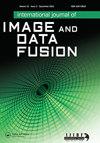一种基于旋转校准最小二乘支持向量机的多源数据分类集成方法
IF 1.8
Q3 REMOTE SENSING
International Journal of Image and Data Fusion
Pub Date : 2021-01-02
DOI:10.1080/19479832.2020.1821101
引用次数: 2
摘要
提出了一种扩展的基于旋转的多源光学雷达数据集成分类方法。该方法实际上是受到基于旋转的支持向量机集成(RoSVM)的启发,并进行了一些基本改进。在第一次修改中,由于最小二乘支持向量机的速度更快,因此使用最小二乘支持向量机代替支持向量机。第二个修改是应用Platt校准版本而不是经典的非概率版本,以便考虑更适合类的概率。在第三次改进中,为了进一步提高所提出方法的速度,使用了基于滤波器的特征选择算法而不是包装算法。在最后的改进中,将传统的多数投票方法替换为性能更好、模糊度更小的客观多数投票方法来融合单个分类器。因此,所提出的方法被称为旋转校准最小二乘支持向量机(RoCLSSVM)。然后,将其与其他基于svm的版本以及RoSVM进行比较。结果表明,对于本文数据集的分类,RoCLSSVM比RoSVM具有更高的准确率、效率和多样性。此外,RoCLSSVM对训练大小的敏感性低于RoSVM。本文章由计算机程序翻译,如有差异,请以英文原文为准。
An ensemble method based on rotation calibrated least squares support vector machine for multi-source data classification
ABSTRACT This paper proposed an extended rotation-based ensemble method for the classification of a multi-source optical-radar data. The proposed method was actually inspired by the rotation-based support vector machine ensemble (RoSVM) with several fundamental refinements. In the first modification, a least squares support vector machine was used rather than the support vector machine due to its higher speed. The second modification was to apply a Platt calibrated version instead of a classical non-probabilistic version in order to consider more suitable probabilities for the classes. In the third modification, a filter-based feature selection algorithm was used rather than a wrapper algorithm in order to further speed up the proposed method. In the final modification, instead of a classical majority voting, an objective majority voting, which has better performance and less ambiguity, was employed for fusing the single classifiers. Accordingly, the proposed method was entitled rotation calibrated least squares support vector machine (RoCLSSVM). Then, it was compared to other SVM-based versions and also the RoSVM. The results implied higher accuracy, efficiency and diversity of the RoCLSSVM than the RoSVM for the classification of the data set of this paper. Furthermore, the RoCLSSVM had lower sensitivity to the training size than the RoSVM.
求助全文
通过发布文献求助,成功后即可免费获取论文全文。
去求助
来源期刊

International Journal of Image and Data Fusion
REMOTE SENSING-
CiteScore
5.00
自引率
0.00%
发文量
10
期刊介绍:
International Journal of Image and Data Fusion provides a single source of information for all aspects of image and data fusion methodologies, developments, techniques and applications. Image and data fusion techniques are important for combining the many sources of satellite, airborne and ground based imaging systems, and integrating these with other related data sets for enhanced information extraction and decision making. Image and data fusion aims at the integration of multi-sensor, multi-temporal, multi-resolution and multi-platform image data, together with geospatial data, GIS, in-situ, and other statistical data sets for improved information extraction, as well as to increase the reliability of the information. This leads to more accurate information that provides for robust operational performance, i.e. increased confidence, reduced ambiguity and improved classification enabling evidence based management. The journal welcomes original research papers, review papers, shorter letters, technical articles, book reviews and conference reports in all areas of image and data fusion including, but not limited to, the following aspects and topics: • Automatic registration/geometric aspects of fusing images with different spatial, spectral, temporal resolutions; phase information; or acquired in different modes • Pixel, feature and decision level fusion algorithms and methodologies • Data Assimilation: fusing data with models • Multi-source classification and information extraction • Integration of satellite, airborne and terrestrial sensor systems • Fusing temporal data sets for change detection studies (e.g. for Land Cover/Land Use Change studies) • Image and data mining from multi-platform, multi-source, multi-scale, multi-temporal data sets (e.g. geometric information, topological information, statistical information, etc.).
 求助内容:
求助内容: 应助结果提醒方式:
应助结果提醒方式:


